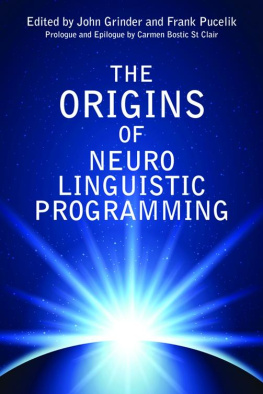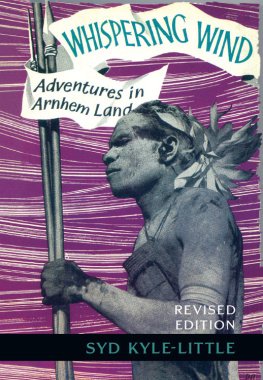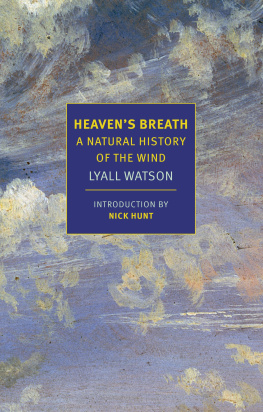John Grinder - NLP -Whispering in the Wind
Here you can read online John Grinder - NLP -Whispering in the Wind full text of the book (entire story) in english for free. Download pdf and epub, get meaning, cover and reviews about this ebook. year: 2010, genre: Home and family. Description of the work, (preface) as well as reviews are available. Best literature library LitArk.com created for fans of good reading and offers a wide selection of genres:
Romance novel
Science fiction
Adventure
Detective
Science
History
Home and family
Prose
Art
Politics
Computer
Non-fiction
Religion
Business
Children
Humor
Choose a favorite category and find really read worthwhile books. Enjoy immersion in the world of imagination, feel the emotions of the characters or learn something new for yourself, make an fascinating discovery.
- Book:NLP -Whispering in the Wind
- Author:
- Genre:
- Year:2010
- Rating:4 / 5
- Favourites:Add to favourites
- Your mark:
- 80
- 1
- 2
- 3
- 4
- 5
NLP -Whispering in the Wind: summary, description and annotation
We offer to read an annotation, description, summary or preface (depends on what the author of the book "NLP -Whispering in the Wind" wrote himself). If you haven't found the necessary information about the book — write in the comments, we will try to find it.
NLP -Whispering in the Wind — read online for free the complete book (whole text) full work
Below is the text of the book, divided by pages. System saving the place of the last page read, allows you to conveniently read the book "NLP -Whispering in the Wind" online for free, without having to search again every time where you left off. Put a bookmark, and you can go to the page where you finished reading at any time.
Font size:
Interval:
Bookmark:
Authors' Guide for the Reader/Preface to Whispering in the Wind It is with great excitement and pleasure that we offer this book to the Neuro-Linguistic Programming (NLP) community. Its publication seems to us to be most timely. The legal controversies surrounding Neuro-Linguistic Programming have been recently settled in such a way that there are at present no further obstacles to an intelligent and appropriate professional development of this field that holds such great promise (see appendix A for documents detailing the legal settlements that have cleared the way for this development).
NLP has been carried on the wind to all corners of the earth in the short time it has existed. The initial work by its co-creators, John Grinder and Richard Bandler, was done in the mid - 70's in California. The patterning coded by them in their initial modeling of geniuses has been translated into many languages, adapted to a large number of cultures and integrated into countless domains of application. It has touched profoundly the lives of hundreds of thousands of people, making positive contributions to the quality of their lives.
Our motivations for writing this book are multiple. First, we were moved by a concern about the emphasis and direction that NLP has recently taken. In particular, we refer to the lack of modeling
the very activity that defines the core of this discipline NLP. Our thought was that if we could identify cleanly the primary strands of influence, both intellectual and personal, that shaped the context in which NLP was formed, it would give some depth to the enterprise. Further, there is nowhere available any published descriptions of the processes by which the initial modeling that created the field of NLP occurred. Similarly, the contexts in which these processes occurred have never been revealed. It hardly seems appropriate (and it is certainly not effective) to exhort people to do something without offering some guidance on how to accomplish it.
We begin by identifying the epistemology underlying the entire enterprise of NLP. We subsequently present the principle threads, both personal and intellectual, that were woven together to create this fabric of many colors.
We then select and describe a series of key incidents in the modeling activities that created NLP.
Our intention for so doing is that by presenting such narratives, we could point to specific strategies (both literally and metaphorically) that have proven effective in the modeling of excellence. In particular, we develop extended descriptive narratives that define what philosophers of science refer to as contexts of discovery. Our intention, then in this enterprise, is to encourage others to think and act with clarity in responding to the tremendous opportunities that the technology called NLP offers to intrepid explorers. Such enlightened self-interest will hopefully drive the further development of the field as a natural consequence.
Without an appreciation of its foundation, historically and epistemologically, there is a tendency for a new discipline such as NLP to drift on the wind. We present a number of tether points, strong enough to resist inappropriate drift but with enough slack to allow flexibility and some grace in its movement.
Finally, we offer extended commentary on the practice of NLP and how we as a community might refine and extend such practice. These include specific proposals about how to improve the actual application of the patterning created through modeling processes. We conclude with a set of recommendations about how we might organize ourselves as a legitimate research community, and a commentary on its possible application to wider social contexts.
The discipline of Neuro-Linguistic Programming had a reasonably spectacular infancy and has, more or less, survived a tumultuous adolescence. We propose that it is now time to establish it as a professional discipline taking its rightful place along side other approaches to the study of human functioning. NLP has and will continue to contribute significantly to the study of human behavior and in particular, to that extreme form of human behavior we refer to as excellence. The field is far more important than the two men who founded it: it now has a life of its own. In part, what follows is an attempt to make transparent certain aspects of its creation and development if for no other justification than to allow it to move beyond the personalities of its co-creators.
Whispering is not a typical NLP book - in particular, those seeking another how-to presentation of NLP patterning of excellence should look elsewhere. The book assumes a certain level of familiarity with NLP patterning and concerns itself with larger and more profound issues - ones that, in our opinion, will determine whether NLP reinvigorates itself and continues to develop or simply is swept away on the wind.
Nor will we use this book to offer a report of the patterning in large organizations - corporations, institutes and governments that has been the focus and principal activity of Quantum Leap and its principals, Carmen Bostic St. Clair and John Grinder during the last decade. Our intention here is quite different.
The book is organized into 3 sections, each with multiple internal chapters as follows: The Lull Before the Storm
1. Preface
2. Prologue: offers some simple opening remarks about the current context in which we find NLP and some typical contemporary perceptions of it.
Part I: A Freshening Wind
Chapter 1: Epistemology - an explicit presentation of the epistemology underlying NLP.
The reader is warned that this section requires close attention. While it is possible to appreciate many portions of the succeeding material without an explicit understanding of the epistemology presented in this section, we consider it crucial to any serious student of the technology. We argue for a sharp distinction between the set of neurological transforms that process the incoming data stream from the world up to the point where we as humans first gain access to it (primary experience) and the set of transforms subsequent to that point, focusing on the linguistic mapping and their effects (secondary experience).
Korzybski's famous map/territory distinction is challenged and refined. Some of the implications for NLP are explored.
Chapter 2: Terminology: a number of key terms in NLP and in particular for this book are defined with commentary.
Chapter 3: Intellectual Antecedents of NLP: here we identify and characterize the most influential sources of the strategies, methodologies and patterning that deeply influenced the co-creators, John Grinder and Richard Bandler, and the processes that they used during the creation of NLP.
Chapter 4: Personal Antecedents: a representation from the point of view of one of the two co-creators of NLP of the personal characteristics that played an important role in the discovery processes that created the field of NLP. The reader is reassured that the accidents of one person's tortuous personal history represents only one (and a quite unlikely one) way of achieving the skills necessary to engage in the modeling of excellence.
Part II: The Eye of the Storm
Chapter 1: Contexts of Discovery: a series of historical narratives with commentary in which the reader is invited to consider how specifically the initial modeling of genius and the associated activities .that created the field of NLP occurred. Special attention is paid to the contexts and processes of discovery.
Chapter 2: The Breakthrough Pattern: we make explicit the features of NLP that distinguish it from other systems of change. We then offer a historical narrative, describing the emergence of the breakthrough pattern that casts a revealing light on certain unfortunate choices made by Bandler and Grinder in their enthusiastic initial coding of the patterns of excellence in the NLP's classic code. After an analysis of the breakthrough pattern, we offer a critical analysis of the classic code illuminated by the differences revealed in the breakthrough pattern.
Next pageFont size:
Interval:
Bookmark:
Similar books «NLP -Whispering in the Wind»
Look at similar books to NLP -Whispering in the Wind. We have selected literature similar in name and meaning in the hope of providing readers with more options to find new, interesting, not yet read works.
Discussion, reviews of the book NLP -Whispering in the Wind and just readers' own opinions. Leave your comments, write what you think about the work, its meaning or the main characters. Specify what exactly you liked and what you didn't like, and why you think so.













